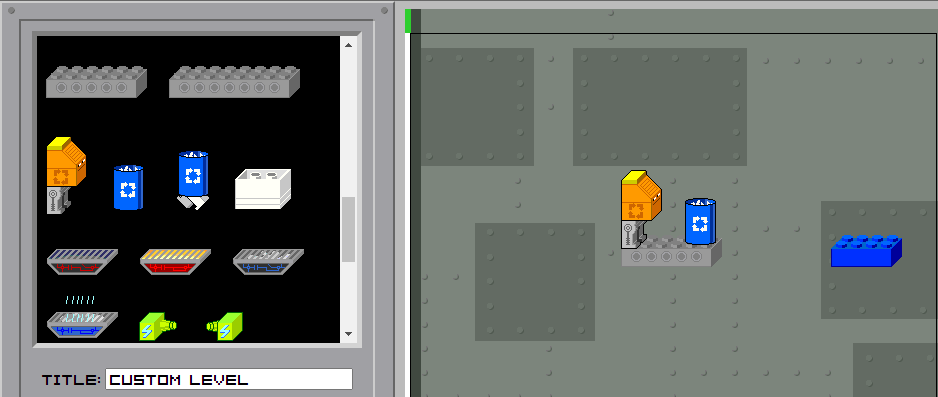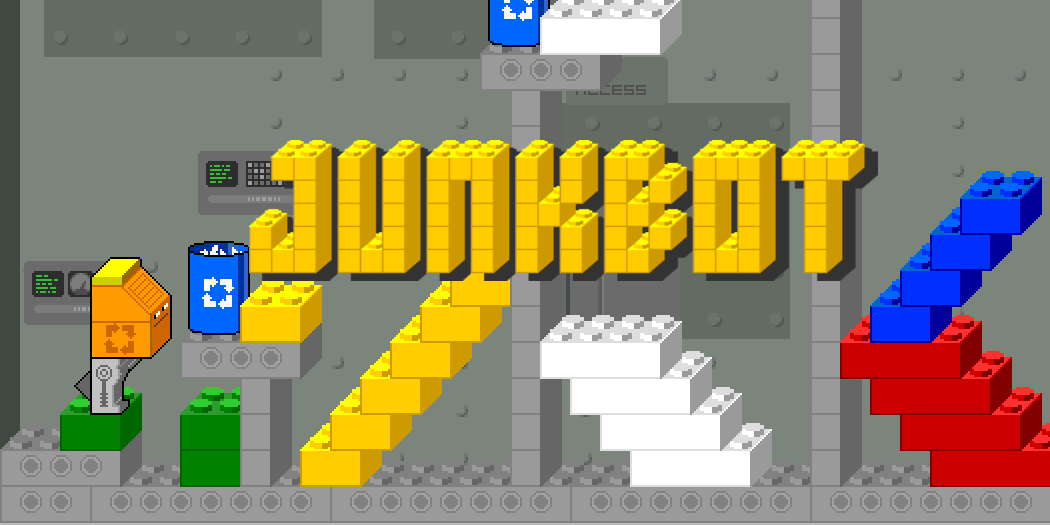
23 years ago today, LEGO's Junkbot game was released, one of the most popular LEGO.com games of all time 🤖🧱
Jump to:
Junkbot: The mysterious little LEGO robot that relentlessly walked forward, and deserved far more attention than it ever received. 23 years ago, the first of 2 games featuring the orange walker was released on LEGO.com! Who made it, and where is Junkbot today?
This is a long article (4k+ words), so you might want to skip straight to “How can I play Junkbot today?”, or “Are there any secrets?”!
What is Junkbot?
Junkbot is a puzzle game from 2001 with 60 levels, previously hosted on LEGO.com. Junkbot relentlessly walks forward, turning around when hitting a wall, with the goal of eating all the trashcans in a level.
There are environmental threats (fire, drips, fans, springs)1 and enemies (gearbot, climbbot, flybot), but the main challenge is just getting Junkbot around the level without dying. Whilst most levels can be solved through trial and error, there is also an optional maximum moves target for each level.
Junkbot itself is perhaps summarised best by Naomi Clark2:
He’s not super-powered. He just likes to eat trash … He’s a robot whose goal in life is to eat trash.
There is a sequel, “Junkbot Undercover”, but this article is only interested in the first game!
| Guide | Gameplay |
|---|---|
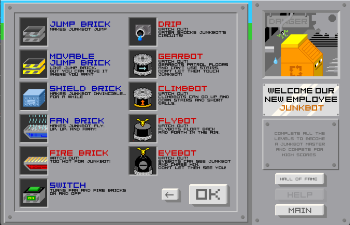 |
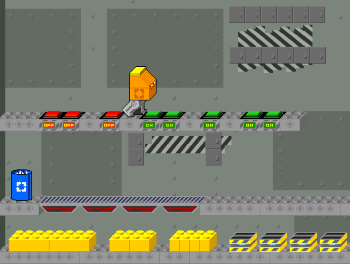 |
Timeline
- Spring 2000: gameLab (Junkbot’s creator) founded3.
- October 2000: gameLab’s NYC office opened4.
- August 9th 2001: Junkbot released5 (also shown on gameLab’s Junkbot page6 and in a LEGO press release7).
- September / October 2001: First mentioned in official LEGO mania magazine8.
- October 5th 2001: First archive.org mention of Junkbot on LEGO’s site9.
- August 3rd 2002: First archive.org copy of Junkbot game files10.
- October 24th 2003: Junkbot included in a case study by gameLab’s CEO for “Design Research”11.
- September 29th 2009: gameLab acquired12.
- July 31st - September 30th 2012: Junkbot is removed from LEGO.com (July 30th, September 30th), likely as part of the 2012 site-wide redesign13(?).
- April 9th 2019: Shockwave Player (required for Junkbot) no longer available to download14.
 Interest since 2004 (earliest available) for “Junkbot”, from Google Trends15.
Interest since 2004 (earliest available) for “Junkbot”, from Google Trends15.
How can I play Junkbot?
Whilst you absolutely can install and play the original Junkbot, I’d actually recommend a HTML5 remake (more info later in Play Junkbot online) for ease of use. It’s missing the music (for copyright reasons), but has extra features!
Installing Junkbot
If you’d rather play the original, the Flashpoint Archive project can help (FAQs). It’s on Windows, Mac & Linux, and currently makes 150k+ old Flash / Macromedia games playable. Here’s how to set it up:
- Download Flashpoint Infinity: “Ultimate” includes all games and is massive, you don’t want that!
- Run the installer: I only installed the “Core Components”, since games prompt for any additional extensions they need.
- Open Flashpoint & search for Junkbot: The program can be a little unresponsive, but Junkbot should eventually show up.
- Play!
| Installing Flashpoint | Searching for Junkbot | Playing Junkbot |
|---|---|---|
 |
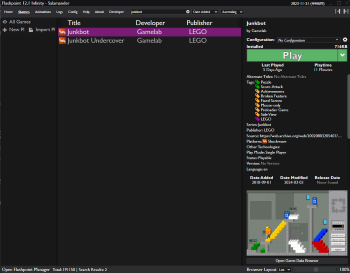 |
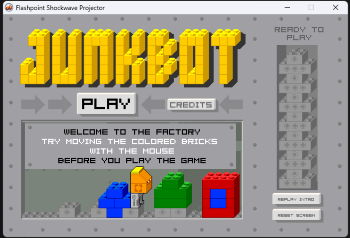 |
Note the game files provided by Flashpoint have a created date of 24/12/1996. This is unrelated to Junkbot, and is a quirk of the utility “TorrentZIP”.
Technical
How was Junkbot created?
Junkbot was created in the now abandoned Adobe Director, a less popular relative of Adobe Flash. To decompile the game files I used “ProjectorRays”, and wrote a full decompiling guide.
Whilst working on this post I also extracted Junkbot’s source code, meaning all the game’s code and assets are now available on GitHub! This lets you dive into how every feature within the game works, like dynamically generated animations, all implemented using the obscure language “Lingo”.
Are there any secrets?
There are some!
Level editor
First, there’s a level editor used by the developers to create the game’s levels. This was accessible via a button in each level, and all of the code still exists in the game.
This level editor has all the features you’d expect: selecting bricks to place, checking a brick fits, editing levels, exporting to text, and more. I couldn’t get this actually running in the game, but it exists!
Secret level names
Before the game’s 60 levels were organised into 4 buildings, draft versions were built by various developers (mostly Frank and Eric, with some by James(?), Nick, Ranjit, and Peter).
How do I know who made the levels? There’s a text file with the level names and authors!
This is obviously an informal, casual level list, with some particular highlights being:
- “Shit Stormsof Floaters by Eric (exciting!!! )”
- “Temple of Doom! by Eric (hard (but not too frustrating) complex level )”
- “fires and fans by Eric (a few ways to solve it… )”
More importantly than the actual level names however, is the variety of people creating levels. The fact everyone from the CEO to programmers are playing around and making levels show how invested the entire gameLab team was in Junkbot.
About Junkbot
Who created Junkbot?
Junkbot was created by “gameLab”, a company of 6 founded in early 2001 by Eric Zimmerman and Peter Lee “simply because we wanted to make games”16. They quickly found work creating web games for LEGO.com due to their connections made whilst working on the extremely popular Sissyfight 200017. gameLab’s story has been told in detail elsewhere (e.g. Wikipedia), with a LEGO podcast episode centred around Junkbot2 (transcript).
The game includes credits (image below), although the nature of a small company is roles often aren’t very strictly defined! For example, Peter is listed as contributing to Art, Code, and Project Management, but also credit for the “cheeky design of the Junkbot itself … [he] deserves credit for that original design”18.
These names are mostly taken from gameLab’s website in October 200119 and are all included in Junkbot’s August 9th press release20. I’ve included their bios verbatim, plus added information on their work in the last 20 years when appropriate. It’s worth noting the extraordinarily high levels of continued collaboration even decades later, and how most continued to publicly talk about games and educate others.
Eric Zimmerman (Founder & CEO)
Eric Zimmerman just can’t stop making games. After a childhood of roping friends and family into playtesting his game experiments, Eric has spent the last eight years in the game industry. Before founding gameLab with Peter Lee, Eric collaborated with Word.com on the underground online hit, SiSSYFiGHT 2000 (www.sissyfight.com). Other titles include the PC CD-ROM titles Gearheads (Philips Media, 1996) and The Robot Club (Southpeak Interactive, 1998). An unapologetic part-time academic, Eric has taught game design at MIT, NYU, and Parsons School of Design and he is the Director of RE:PLAY, a series of events examining game design and game culture. He is currently working on two books about game design and game culture, to be published in 2002 by MIT Press and Eyebeam Atelier. Eric has exhibited non-computer game projects at galleries and museums in the US and abroad.
Zimmerman has continued creating / writing about / speaking about games relentlessly since Junkbot, with additional focuses on play and design both inside and outside of academia. He is on Twitter/X as @zimmermaneric, and has links to much of his content on ericzimmerman.com (e.g. Junkbot!).
Peter Lee (Founder & President)
Peter is a digital media renaissance man, equally skilled in visual design, game design, and game programming. Peter began his career as a designer for TIME online, where he designed the award-winning web content feature “Last call: Face of Alcoholism.” He has held a number of positions since then, including Director of Technology at Churchill Communications, a New Jersey-based Medical Communication Company. where he managed web and CD-ROM projects and lead IT research and technical development. Peter also helped found the Game division at Funny Garbage, developing several online games for the Cartoon Network website. He currently holds an Adjunct Professorship at New York University’s Interactive Telecommunications Program, where he teaches Game Development.
Lee (no relation) has continued contributing to games (often with Zimmerman) since his time at gameLab, including “Additional Thanks” in 2013’s Rogue Legacy21. He has since helped start gaming festivals and nonprofit schools22, a Korean “big game” (e.g. immersive experience) design studio Nolgong23, and speaks at events worldwide (e.g. Germany24 & Hong Kong25).
Frank Lantz (Director of Game Design)
Before joining gameLab, Frank was Creative Director of the New York design firm R/GA Interactive, where he worked on a wide variety of game projects including the PC games Gearheads and The Robot Club, as well as multiple online and site-based games for such clients as Microsoft, Sony, The Discovery Channel, NASDAQ, and Children’s Television Workshop. Frank is a member of the faculty of NYU’s Interactive Telecommunications Program, where he teaches classes in game design and interactive narrative. His writing on games, technology and culture has appeared in a variety of publications. Frank is also the co-designer of several massively multiplayer real-world conference games including Quorum for the Re:Play Conference, MANIFESTO for AIGA’s Collison conference, and LiNK for Flashforward 2000.
Lantz (along with plenty of other former gameLab employees) teaches at NYU Game Center26, and continues to create games. Many of his talks, papers, and games (e.g. Junkbot!) are available on franklantz.net.
Coincidentally, I’ve unknowingly spent many hours with one of Lantz’s recent games (2017): Universal Paperclips27. This is one of the most popular incremental / clicker games of all time, with a detailed Wikipedia article28 and “In the first 11 days, 450,000 people played the game, most to completion”29. It is based on the “paperclip maximizer” AI thought experiment, even more relevant today with the relentless pace of AI innovation.
Ranjit Bhatnagar (Director of R&D)
Ranjit has been involved with digital art on the Internet before the Web ever existed: he helped found sito.org, a pre-WWW collaborative arts community. For the last several years, Ranjit has been on the board of SCAN, an old-school annual digital arts conference dating back to 1979 . Ranjit was a member of the original design and implementation team for the Philadelphia Inquirer¹s website. Later, he worked as the Director of Technology at Word Magazine, where he led the technical development of the art toy Pixeltime (pixeltime.com) and the award-winning multiplayer game Sissyfight (www.sissyfight.com). Unsatisfied merely making games for a living, in his spare time Ranjit creates alternative musical instruments, such as the Silence Organ and the MIDI Ironing Board. His art and installations have appeared in solo and group exhibitions in California and Pennsylvania. Personal site: www.moonmilk.com.
Bhatnagar has maintained moonmilk.com for the past 30(!) years, writing articles about various creative things he has been up to. Music, writing, programming, art, photography30, it’s got it all.
Additionally, according to Brian Crecente2: “Of all the games he worked on Ranjit Bhatnagar said that Junkbot remains his favorite”.
Nicholas Fortugno (Game Designer)
Nick was inducted into role-playing life at the age of five, and has been an avid consumer and producer of role-playing, live-action, and game culture ever since. Nick’s bizarre sense of interactive aesthetics have led him to design a number of role-playing universes and narrative games; most notably, he founded and ran the Seasons of Darkness group, a 5 1/2 year live action project which was featured on Showtime. Nick’s work on Seasons introduced him to Eric Zimmerman, and that introduction eventually brought him to gameLab. Nick also holds a Adjunct Teaching position at Bronx Community College, where he teaches developmental and compositional English, and is currently pursuing graduate study at Hunter College. In his spare time, Nick studies classical guitar, apprentices in T’ai Chi, and subjects more hapless players to his role-playing/art experiments.
Fortugno continued creating games at various studios (Rebel Monkey, Playmatics), and as with many other gameLab employees, continues writing and teaching31 about games. His work can be seen at nickfortugno.com.
Michael Sweet (Music & Sound Design)
Award winning composer and sound designer, Michael Sweet is a frequent collaborator with gameLab and his work can be heard in many of their games, including Shockwave’s audio award winning BliX. Michael is the Creative Director of his own Silicon Alley music and sound design house Blister Media. After graduating from highly regarded Berklee College of Music, Michael’s digital artistry led him to specialize in creating interactive scores for cutting edge new media projects. Credits include: the ground breaking multiplayer game Netwits for MSN, Shockwave’s Loop, award-winning kiosks for the Discovery Network stores, and Sesame Workshop’s Passport Kids. In broadcast, Michael’s work can also be heard in many commercials and network identities, including HBO-Zone, CNN, General Motors, Kodak, and AT&T. Working with other digital artists, Michael sound sculptures have been exhibited at museums in London, Florence, Amsterdam, Toronto, and New York, and Hong Kong.
Sweet wasn’t actually part of gameLab, but instead half of Blister Media32 (Creative Director, founded 199833) that frequently collaborated with gameLab. He’s an non-fiction author34 and currently a Professor at Berklee College of Music35.
Naomi Clark (LEGO Web & Digital Producer)
Whilst not part of gameLab, Naomi (who also teaches at NYU Game Center36) was producer of Junkbot for LEGO.com37. This period is summarised in the LEGO podcast “Bits n Bricks” S3E292 (transcript):
That connection between Clark, Zimmerman and the rest of the Gamelab crew would eventually lead to a lasting relationship between Gamelab and the LEGO Group, with the studio creating a dozen games for the website. But the first was, perhaps, the most memorable: Junkbot. When Clark approached Gamelab about making a game, the studio came up with a twopart pitch document that explored the play values of the LEGO Group and offered up a number of ideas.
She later ended up working at gameLab (and many other studios) as a Game Designer, and can be found on Twitter/X as @metasynthie.
What inspired Junkbot?
As shown by the draft list of levels, most gameLab employees contributed directly to Junkbot in one way or another. Due to the highly collaborative nature of gameLab’s design process (see next section), it’s perhaps impossible to determine exactly who contributed what during the game’s under 6 month development38.
Most of the details in this section are from a detailed podcast with some former gameLab / LEGO employees in 20212, with a transcript available. The podcast covers Junkbot, LEGO’s game making process, and related topics.
The original idea pitched to LEGO as gameLab’s first provided game was, according to gameLab CEO Eric Zimmerman:
about a character that walked on its own, in a sort of a 2D platformer kind of world, and that you were building staircases and moving LEGO bricks around to kind of help them get around.
Eric describes the “important design lesson” the team learned in creating Junkbot, as unlike most games where the core mechanic drives the game, in Junkbot:
Sometimes you make a cake and it’s so good you don’t need the frosting, and other times the frosting makes the cake. So in the case of Junkbot, it was the frosting.
…we had a hard time making levels. We just had to add stuff to the game. We had to add obstacles, hazards, enemies, power-ups, and then the game started getting fun
By this, he presumably means the core mechanic of Junkbot walking and the player moving LEGO bricks is the “cake”. It works, it’s functional, but it doesn’t provide much fun. The enemies, hazards, and hints of story are the “frosting” that make the game what it is. Or, in his words:
The core mechanic was conceptually interesting but experientially lacking.
The team evidently spent a lot of time on this core mechanic, as Michael (Sound Design) “sent us dozens of different prototypes for the sounds of bricks clicking together and the sound of bricks being pried apart”. Similarly, “we had tons of brainstorming meetings, talking about possibilities for, how do you make something that feels like pulling apart and sticking together these LEGO bricks, but also then becomes a really challenging and interesting and fun game?”.
This focus on LEGO bricks and their interactions were likely influenced by LEGO’s Naomi, as she “was kind of really interested in making games that were genuine expressions of the fun of LEGO bricks as a toy”.
One certainty is around the Junkbot character itself’s appearance, which according to Eric: “Peter Lee deserves credit for that original design … I guess there’s a sort of R2-D2, like cute robot pet appeal to Junkbot.”
gameLab’s design process
There’s an absolutely excellent academic paper by Alice J. Daer in 2010 focused on gameLab’s design processes39, and covers them in far more detail than I ever could. The information is mostly provided by Nick Fortugno, and covers collaboration within the team, designing experiences not levels, what it means to design, and far more. A few select quotes:
- “In sum, making games at Gamelab was a deeply contemplated effort, one that incorporated regular deliberative practices and reflections on those practices.” (Alice)
- “each member of the team was expected to be an equal contributor” (Alice)
- “employees were given a monthly allowance so that they could purchase games and game-related things to help stimulate their creativity and knowledge of a variety of ideas and rule systems” (Alice)
- “You can design a kind of emotional response. You can design a mental, physical, and social response and that’s when it’s interesting, because those things become meaningful experiences for people.” (Nick)
- “I noticed that Nick, as the lead on the project, turned the argument into a teaching moment, trying to lead Mattia to the same conclusions that he, Nick, had already reached.” (Alice)
- “Ultimately, an argument was settled through building the game prototype or level and then playing it” (Alice)
I’d highly recommend giving the full (free) paper a read if at all interested in game design: https://journals.sagepub.com/doi/pdf/10.2304/elea.2010.7.1.108
Note that Junkbot is incorrectly referred to only as “Jumpbot” on page 10, suggesting even by 2010 gameLab’s first LEGO game had mostly dropped from the public consciousness!
Junkbot’s legacy
Despite Junkbot’s relatively obscure status as a cult classic over the last 20 years, it is by no means forgotten. As well as the occasional fan content or nostalgic Reddit post, there are even subtle references in official LEGO products.
Unofficial LEGO builds
With the LEGO fanbase making unofficial sets of almost everything on Earth, it’s perhaps not too surprising that Junkbot has had plenty of MOCs (My Own Creations) created over the years.
Of special note is JK Brickworks’ 8:1 scale model from 2003, and jxu’s improved 2020 version with instructions:
| JK Brickworks40 | jxu41 |
|---|---|
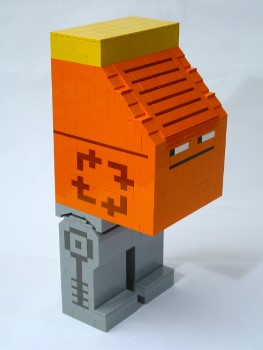 |
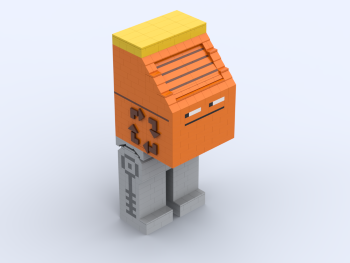 |
In addition to builds of Junkbot itself, there’s been all kinds of related content:
- A Junkbot themed LEGO pirate ship.
- An ode to Junkbot, that ends up asking surprisingly intriguing questions about the world of Junkbot!
- A rip of the game’s funky soundtrack.
- MOCs of the game’s enemies.
Official LEGO easter eggs
Junkbot clearly has fans within LEGO too, since it continues to pop up in odd little places now and then. The first two sets are explicitly mentioned in a “Bits N’ Bricks” podcast, with the third being added as recently as 2025!
The little bot Junkbot, or references to it, have popped up in a Ninjago theme set and the Haunted House set as well42
70657: NINJAGO City Docks
2018’s NINJAGO City Docks set seems to have no relation to Junkbot initially, however there is an entire Junkbot-themed arcade cabinet hidden inside the blue arcade room.
This is just an arcade cabinet with Junkbot’s colours and some stickers, but it’s great to see the memory living on 17 years later. Here’s how it looks:
| Hand-held43 | In context44 | All arcade machines45 |
|---|---|---|
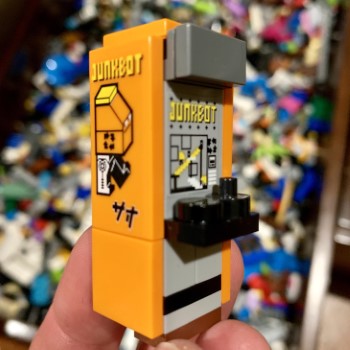 |
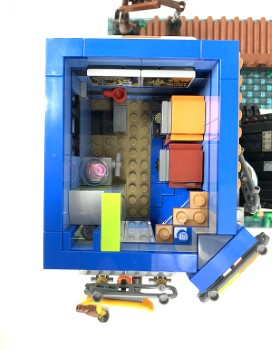 |
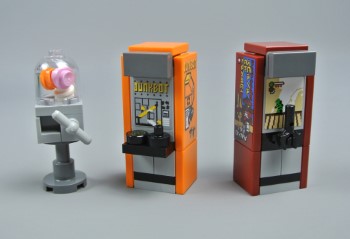 |
10273: Haunted House
2020’s Haunted House set is even further detached from Junkbot, and the reference is far more subtle!
| Minifigure 46 | In disguise as a “box of junk” 46 |
|---|---|
 |
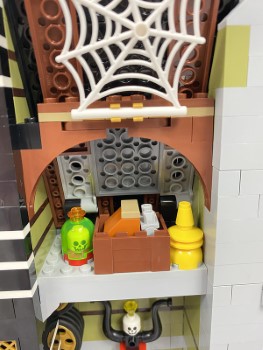 |
40805: Arcade Machine
2025’s Arcade Machine set has an absolutely adorable mini-arcade machine directly referencing Junkbot!
| Junkbot arcade machine47 | In context47 |
|---|---|
 |
 |
LEGO Builder’s Journey
With the excellent LEGO Builder’s Journey having many similarities to Junkbot, albeit in a more relaxed style, it might seem obvious that one inspired the other. Alas, this isn’t the case, as described by Brian Crecente2:
I actually spoke with Karsten Lund, the Creative Director of Builder’s Journey about it, and he said, he actually hadn’t heard about Junkbot until after Builder’s Journey was designed and someone at the LEGO Group pointed out that this other much earlier web game existed.
… I can’t help but think that, you know, two decades apart, you have these really thoughtful game designers sitting down and trying to figure out what is at the core of LEGO bricks and play and creation, and how can you translate that into something that’s fun … [they] came to the same conclusion and created two very different sorts of games with the same sort of idea at its heart
Play Junkbot online
Whilst Junkbot’s game files can be downloaded from LEGO’s site directly via archive.org48, the game has also been recreated in more modern software (HTML / JavaScript), making it playable in a browser!
1j01’s “Janitorial Android” has clearly had extreme amounts of care put into it, and maybe even made a (controversially!) better game than the original, at least in my opinion. It contains all original functionality, plus lots of new extras. So, what’s changed? Well, here’s what I noticed:
- A complete custom level creator has been added49, as well as the ability to export & import.
- All levels in all 4 buildings are unlocked from the start, instead of further buildings requiring level completion.
- Zooming in and out with mouse wheel (or
+/-). - Minor changes to the audio (e.g. no music)50.
There are tens of additional ideas on the project’s GitHub page if you’re interested in contributing. The impressive project is similar on rozniak’s earlier C# rebuild, but has realistically surpassed it. It’s worth mentioning the two developers were in contact, so there’s no rivalry!
Conclusion
I spent tens of hours playing Junkbot as a child, although I’m sure most of that time was in the first few levels! Junkbot’s excellent character design just made the game irresistable, especially at a time when the quality of web games was typically very low.
Junkbot’s legacy lives on via projects like Flashpoint, references within LEGO sets, and unofficial rewrites. I hope it makes a proper return one day, I feel like Junkbot never quite got the attention it deserved! Hopefully this article helps the legacy last a little bit longer, and reminds people of the little trash-loving robot that just keeps walking.
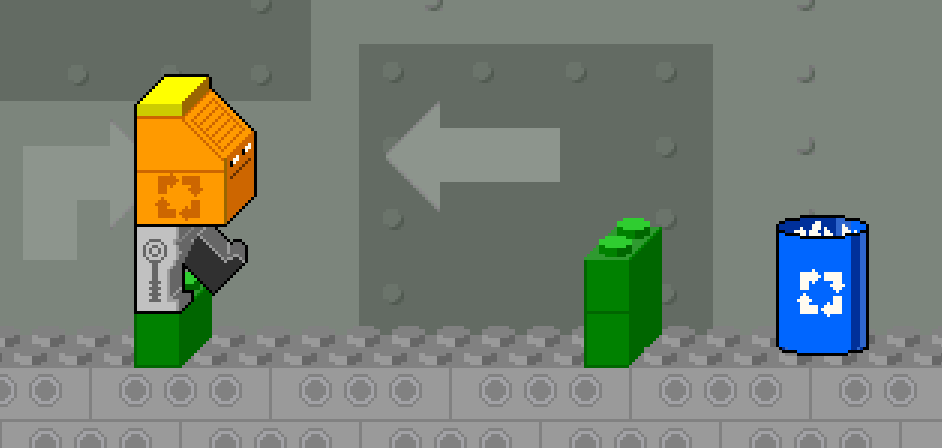
References
-
https://www.youtube.com/watch?v=SKfeyeHIuCY ↩ ↩2 ↩3 ↩4 ↩5 ↩6
-
https://web.archive.org/web/20011108122328/http://www.onemedia.com/archive/zimmerman_jun01.html ↩
-
https://web.archive.org/web/20011027060409/http://www.gmlb.com/pr1.html ↩
-
https://web.archive.org/web/20011027062145/http://www.gmlb.com/pr4.html ↩
-
https://web.archive.org/web/20031009033531/http://gmlb.com/games/junkbot.html ↩
-
https://www.parrygamepreserve.com/media/magazines/lego_mania_magazine/2001/lego_mania_magazine_2001_09_September.php (specifically Page 23) ↩
-
https://web.archive.org/web/20011005164311/http://www.lego.com:80/build/ ↩
-
https://web.archive.org/web/20020803205407/http://www.lego.com:80/build/junkbot/junkbot.asp?x=x&login=0 ↩
-
https://www.google.co.uk/books/edition/Design_Research/xVeFdy44qMEC?hl=en - Available for free on archive.org or from Zimmerman’s site. ↩
-
https://venturebeat.com/business/arkadium-acquires-gamelabcom-game-development-firm/ ↩
-
https://winners.webbyawards.com/2012/websites-and-mobile-sites/general-websites-and-mobile-sites/retail/148871/lego-e-commerce-redesign ↩
-
https://helpx.adobe.com/uk/enterprise/kb/eol-adobe-flash-shockwave-player.html#:~:text=About%20Shockwave%20Player%20end%2Dof,of%2Dlife%2Dfaq.html ↩
-
https://trends.google.com/trends/explore?date=all&q=junkbot&hl=en-GB ↩
-
https://www.vice.com/en/article/xyvnkj/peter-lee-5899ce1770caae4f186fc1ea ↩
-
https://www.lego.com/cdn/cs/set/assets/blte95c26554f38a01a/bits_n_bricks_s03e29_feature_and_transcript.pdf (Page 16) ↩
-
https://web.archive.org/web/20011010051452/http://www.gmlb.com/people.html ↩
-
https://web.archive.org/web/20011027062145/http://www.gmlb.com/pr4.html ↩
-
https://g4c2020.sched.com/speaker/peter_seung_taek_lee.212e7q1s ↩
-
https://zip-scene.com/2016/07/12/mobile-technology-for-analogue-experience/ ↩
-
https://amazeberlin2019.sched.com/speaker/peter_lee_kr.1zducbw8 ↩
-
https://form.hktdc.com/UI_VisitorIntranet/Public/SpeakerDetailPublic.aspx?EVENTID=4621611f-69ea-4ad4-90ea-3826e95d0ee9&SPEAKERID=36bdd58a-fba9-447f-8241-67caa634f2b1&LANGID=1 ↩
-
https://www.wired.com/story/the-way-the-world-ends-not-with-a-bang-but-a-paperclip/ ↩
-
https://www.nytimes.com/2005/11/22/arts/design/video-games-are-their-major-so-dont-call-them-slackers.html ↩
-
https://web.archive.org/web/20020602203847/http://www.blistermedia.com/press/ia/ia.html ↩
-
https://criticalnoise.blogspot.com/1998/10/blister-media-founded-101598.html ↩
-
“Junkbot hit LEGO.com in 2001 after less than half a year of development.” https://www.lego.com/cdn/cs/set/assets/blte95c26554f38a01a/bits_n_bricks_s03e29_feature_and_transcript.pdf ↩
-
https://journals.sagepub.com/doi/pdf/10.2304/elea.2010.7.1.108 ↩
-
https://rebrickable.com/mocs/MOC-50835/jxu/junkbot/#details ↩
-
https://www.lego.com/cdn/cs/set/assets/blte95c26554f38a01a/bits_n_bricks_s03e29_feature_and_transcript.pdf (page 7) ↩
-
https://www.reddit.com/r/lego/comments/d173wv/junkbot_arcade_game_from_ninjago_city/ ↩
-
https://www.eurobricks.com/forum/index.php?/forums/topic/170396-review-70657-ninjago-city-docks/ ↩
-
https://brickset.com/article/36147/review-70657-ninjago-city-docks-(2) ↩
-
https://www.eurobricks.com/forum/index.php?/forums/topic/178084-review-creator-expert-10273-haunted-house/ ↩ ↩2
-
https://www.lego.com/en-gb/product/arcade-machine-40805 ↩ ↩2
-
https://web.archive.org/web/20020803205407oe_/http://www.lego.com/build/junkbot/junkbot2_13g_asp.dcr (Note that this will directly download the
.dcrfile) ↩ -
https://github.com/1j01/janitorial-android?tab=readme-ov-file#some-sounds-taken-from ↩

